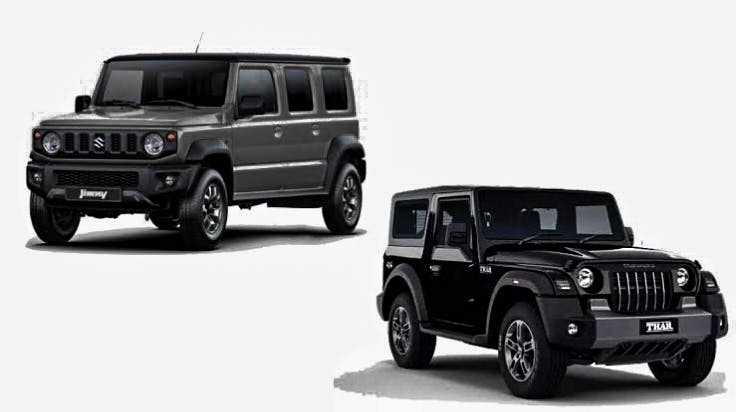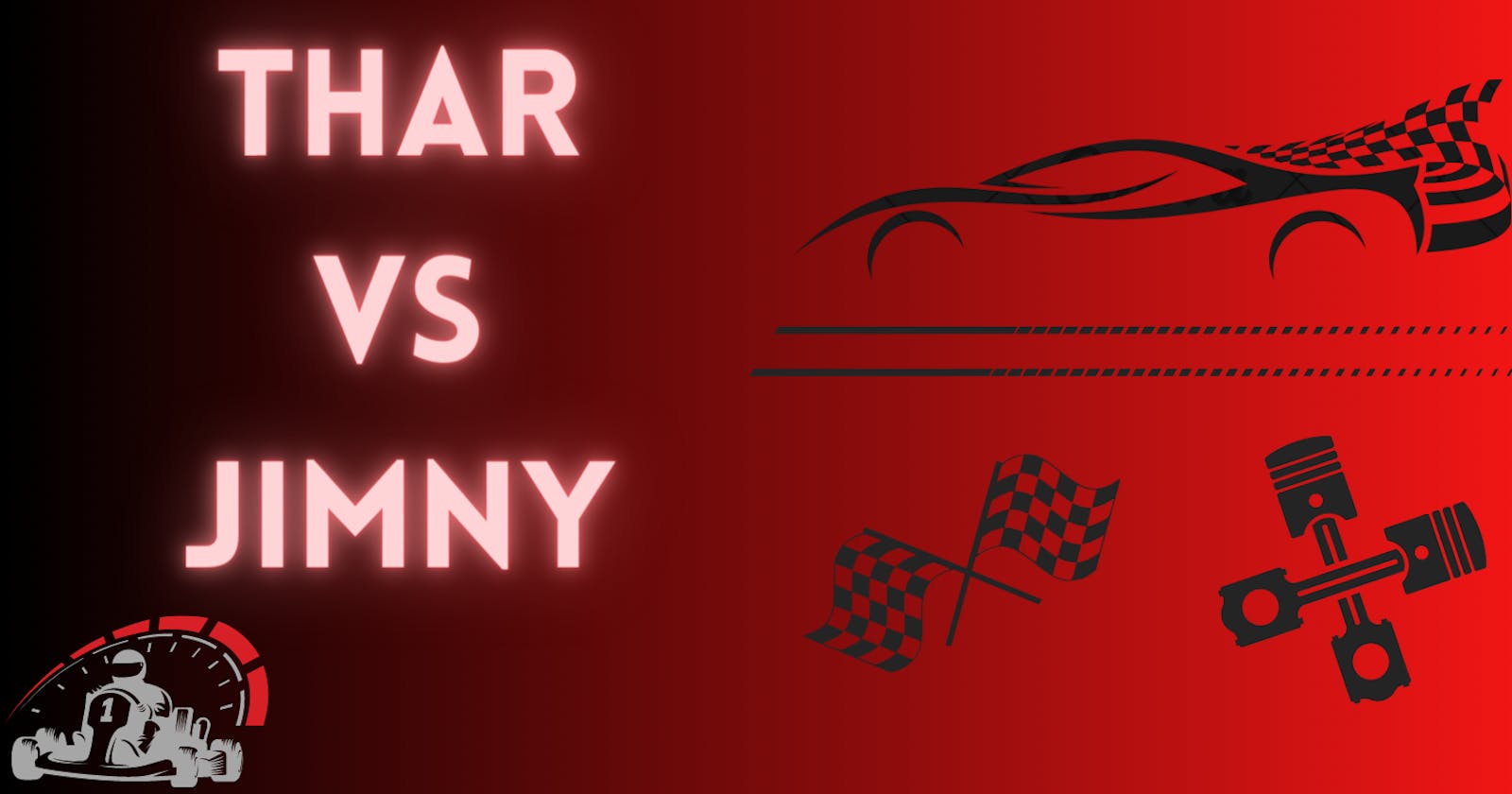Introduction
Two well-known off-road cars that have been drawing a lot of interest from enthusiasts worldwide are the Thar and Jimny. Even though both vehicles are made for off-road adventures, some significant variations between them could affect a buyer's choice. In this blog, we'll take a closer look at these two vehicles and compare them in terms of their design, features, and capabilities.
One of the most eagerly awaited vehicle releases in India is the Maruti Jimny, which revives the market for the low-cost Japanese lifestyle off-roader. With its potent drivetrains and ample off-roading equipment, the Mahindra Thar, which debuted much earlier in 2020, has already raised the standard for the lifestyle 4x4 SUV segment.
So, on an off-road path, can the tiny Jimny compete with the powerful Thar? Here are some specifications and off-roading equipment for the two SUVs.
Design

The Thar is a tough, powerful, and muscular SUV with a vintage Jeep-like appearance. It has a classic look thanks to its boxy form, rounded headlights, and seven-slat grille. With the hardtop and convertible versions of the Thar, drivers can experience open-air driving. Additionally, it offers a variety of customization choices, such as various colour schemes, alloy wheels, and additional accessories.
The Jimny, on the other hand, is a small, adorable-appearing SUV with a boxy form, round headlights, and a five-slat grille. Its straightforward and practical design is evocative of the Suzuki Samurai that it succeeded. With its large windows, high ground clearance, and good approach and departure angles, the Jimny has a more functional appearance. Customers can choose from a variety of colours, as well as roof racks, alloy rims, and other accessories.
Features
With a variety of features, the Thar and Jimny are both capable off-road cars. Two motors are available for the Thar: a 2.2-litre diesel engine and a 2.0-litre turbocharged gasoline engine. Either a six-speed manual or six-speed automatic gearbox is mated to each engine. The Thar is a capable off-road car because it also has a low-range four-wheel drive system. It can navigate most path obstacles thanks to its 219mm ground clearance. Power windows, air conditioning, and a touchscreen infotainment system are additional options.
While the Jimny has a 1.5-litre petrol engine and either a four-speed automatic or five-speed manual gearbox, it also has a low-range four-wheel-drive system, making it a competent off-roader. For its size, it has a ground clearance of 210mm, which is remarkable. The Jimny also has several amenities, such as keyless entry, air conditioning, power windows, and a touchscreen infotainment system.
Capabilities
Basics
Off-road cars that are capable of navigating a variety of terrain include the Thar and Jimny. The Thar is perfect for water crossings because it has a maximum wading depth of 650mm. Additionally, it has an angle of approach of 41.8 degrees, an angle of exit of 36.8 degrees, and an angle of ramp-over of 27 degrees. The Thar can climb over obstacles and move through difficult territory with ease, thanks to these angles.
A ramp-over angle of 28 degrees, an exit angle of 49 degrees, and an approach angle of 37 degrees are all for the Jimny, in contrast. These angles give it off-roading ability, and its small size makes it perfect for traversing narrow trails. The greatest wading depth for the Jimny is 370mm, which is less than the Thar but still remarkable for its size.
| Maruti Jimny | Mahindra Thar |
Approach angle | 36 degrees | 41 degrees |
Departure angle | 50 degrees | 36 degrees |
Ramp break-over angle | 24 degrees | 26.2 degrees |
Ground clearance | 210mm | 226mm |
Height | 1720mm | 1855mm |
Wheelbase | 2590mm | 2450mm |
Weight | 1195kg to 1210kg | Up to 1783kg |
Water wading depth | 300mm | 610mm |
*three-door model’s figure used for reference
The Jimny is shorter and has less ground clearance than the Thar. The Jimny should be able to climb down steep descents because it has a relatively low approach angle but a great departure angle thanks to its stubby back end.
The Jimny has a lower weight figure than the Thar, another benefit. The small Maruti SUV weighs 540 kg less than the Thar, making it more manoeuvrable in some off-road situations.
Due to its larger wheelbase, the Maruti SUV has a relatively reduced ramp break-over angle. Nevertheless, these figures are astounding, and as a side note, both SUVs have a robust aftermarket to allow customization to suit individual requirements.
Suspension
Maruti Jimny | Mahindra Thar | |
Front Suspension | 3-link coil spring suspension | Independent double-wishbone with stabilizer bar |
Rear Suspension | 3-link coil spring suspension | Multilink suspension with stabilizer bar |
Front axle | Solid front axle | Semi-floating axles |
Rear axle | Solid rear axle | Solid rear axle |
An old-school 4x4 enthusiast might drool over the Jimny's suspension system. The front and rear rigid axles offer sturdy construction and excellent wheel articulation all in one. The Thar, on the other hand, has a contemporary independent front suspension but a similar multi-link rigid axle setup in the rear.
Power figures and transmission
| Maruti Jimny | Mahindra Thar 4x4 petrol | Mahindra Thar 4x4 diesel |
Engine and displacement | 1.5-litre naturally aspirated (NA) petrol engine | 2-litre turbo petrol engine | 2.2-litre turbo diesel engine |
Power | 105PS | 150PS | 130PS |
Torque | 134Nm | Up to 320Nm | 300Nm |
Transmission | 5-speed manual | 6-speed manual | 6-speed manual |
Low-range gearbox available | Yes, standard | Yes, only on the 4x4 variant | Yes, only on the 4x4 variant |
Differentials | Brake locking front and rear differential | Brake locking front and rear differential | Brake locking front and rear differential |
Conclusions
Off-road vehicles that give a variety of features and capabilities include the Thar and Jimny. The Jimny has a more practical and compact form than the Thar, which has a more robust and muscular appearance. Both cars have a variety of features, including low-range four-wheel drives that make them perfect for off-road travel. The decision between these two vehicles will ultimately depend on personal preference and requirements.
